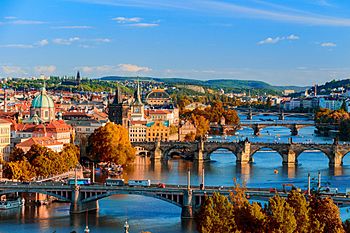Vltava facts for kids
Quick facts for kids Vltava |
|
|---|---|

Vltava in Prague
|
|
| Country | Czech Republic |
| Regions | |
| Cities |
|
| Physical characteristics | |
| Main source | Černý potok Černá hora, Bohemian Forest 1,172 m (3,845 ft) 48°58′29″N 13°33′39″E / 48.97472°N 13.56083°E |
| River mouth | Elbe Mělník 155 m (509 ft) 50°20′29″N 14°28′30″E / 50.34139°N 14.47500°E |
| Length | 430 km (270 mi) |
| Basin features | |
| Progression | Elbe→ North Sea |
| Basin size | 28,090 km2 (10,850 sq mi) |
| Tributaries |
|
The Vltava (vu(u)l-TƏ-və) is the longest river in the Czech Republic. It flows for about 430 km (270 mi) through the country. The Vltava starts in the Bohemian Forest in the south. It then flows north through important cities like Český Krumlov, České Budějovice, and Prague. Finally, it joins another big river, the Labe, near Mělník. Many people call the Vltava the "Czech national river."
The name Vltava comes from old Germanic words. These words likely meant 'wild water'. The German name for the river is Moldau.
The River's Journey
The Vltava River is 430.3 kilometres (267.4 mi) long. It drains a large area of 28,090 square kilometres (10,850 sq mi). This is more than half of a region called Bohemia. It is also about one-third of the entire Czech Republic.
As the river flows through Prague, it is crossed by 18 bridges. One of the most famous is the Charles Bridge. The Vltava covers 31 kilometres (19 mi) within the city of Prague.
The river starts high up, at about 1,172 metres (3,845 ft) above sea level. It ends much lower, at 155 metres (509 ft) where it meets the Elbe. The Vltava actually begins when two smaller streams join together. These are the Warm Vltava (Teplá Vltava) and the Cold Vltava (Studená Vltava). The Warm Vltava is the longer of the two.
Many other rivers flow into the Vltava along its path. Some of the biggest ones are the Otava and Berounka rivers. The Lužnice and Sázava rivers also join it.
Boating and Travel

You can travel by boat on the Vltava River. From where it meets the Elbe at Mělník all the way to Prague, large boats can use the river. These boats can weigh up to 1,000 tonnes (980 long tons; 1,100 short tons).
Further upstream from Prague, towards České Budějovice, smaller boats can travel. These boats can weigh up to 300 tonnes (300 long tons; 330 short tons). However, there are some dams that these larger boats cannot pass. These are the Orlík and Slapy dams. There is also a low bridge at Týn nad Vltavou that blocks them. There are plans to build special boat lifts at the dams and rebuild the bridge. This would allow bigger boats to travel along more of the river.
Even smaller boats, like those used for fun, can get around these obstacles. These boats are usually under 3.5 tonnes (3.4 long tons; 3.9 short tons).
The part of the river near Český Krumlov is very popular for water tourism. Many people enjoy boating and rafting there.
River Dams
Nine hydroelectric dams have been built on the Vltava River south of Prague. These dams help control the river's flow. They also create electricity using the power of the water. The first dams were built in the 1930s.
Starting from the river's source, these dams are:
- Lipno
- Lipno II
- Hněvkovice
- Kořensko
- Orlík
- Kamýk
- Slapy
- Štěchovice
- Vrané
The Orlík dam creates the largest water reservoir on the Vltava by how much water it holds. The Lipno dam creates the largest reservoir by its surface area. The Štěchovice Reservoir was built where there used to be famous rapids called St John's Rapids.
The river also has many weirs. These are like small dams that help slow down the water's flow.
Past Floods
The area around the Vltava River has experienced many floods throughout history. Markers along the river banks show how high the water reached during big floods. Some notable floods happened in 1784, 1845, 1890, and 1940.
The biggest flood recorded was in August 2002. The river overflowed its banks, causing a lot of damage. Prague was heavily affected. The historic Charles Bridge was seriously damaged and needed years of repair work.
Prague was flooded again in 2013. Many places along the Vltava and Elbe rivers were covered in water. This included the Prague Zoo. However, metal barriers were put up along the Vltava's banks. These barriers helped protect the historic city center of Prague.
See also
 In Spanish: Moldava para niños
In Spanish: Moldava para niños




